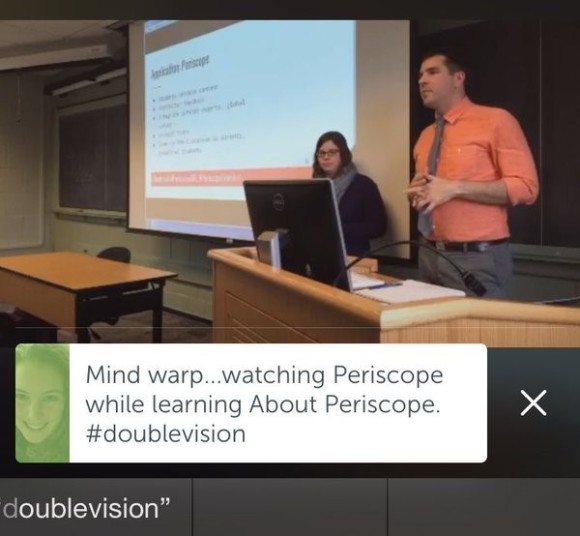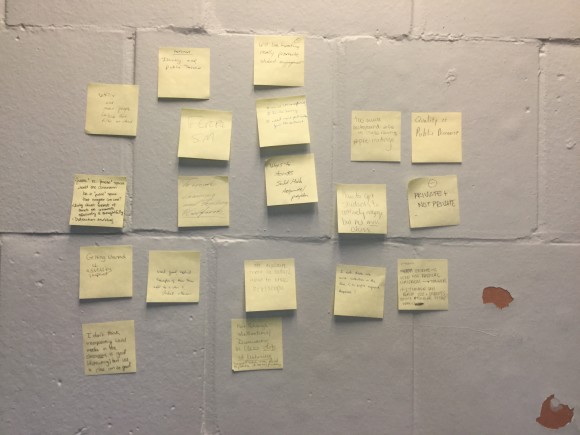ENT 316: Entomology of Field Crops
16 Agricultural Sciences and Industries (ASI) Building
Fridays 12:20pm to 2:15pm, March 18, 2016 to April 29, 2016
Course Instructors:
Karly Regan
542 ASI Building
kjr5470@psu.edu
Elizabeth Rowen
101 Merkle
epr5119@psu.edu
Faculty mentor:
Dr. John Tooker
506 ASI Building
tooker@psu.edu
Office Hours (by appointment):
We are happy to meet with you to discuss the material, assignments, or other concerns about the course. Please contact either instructor by email to schedule a meeting, and we will return messages within 24 hours. You are also welcome to bring questions or concerns to Dr. Tooker, the faculty mentor who oversees the course.
Academic Integrity:
Academic Integrity is highly valued in this class, and we will stress from the first day that you will be required and expected to conduct your work according to the following Penn State policy:
“Academic integrity is the pursuit of scholarly activity in an open, honest, and responsible manner. Academic integrity is a basic guiding principle for all academic activity at The Pennsylvania State University, and all members of the University community are expected to act in accordance with this principle. Consistent with this expectation, the University’s Code of Conduct states that all students should act with personal integrity, respect other students’ dignity, rights and property, and help create and maintain an environment in which all can succeed through the fruits of their efforts.
Academic integrity includes a commitment not to engage in or tolerate acts of falsification, misrepresentation or deception. Such acts of dishonesty violate the fundamental ethical principles of the University community and compromise the worth of work completed by others.”
—From Penn State’s University Faculty Senate Policy 49-20
http://www.psu.edu/advising/integrit.htm
Nondiscrimination:
The Pennsylvania State University is committed to the policy that all persons shall have equal access to programs, facilities, admission, and employment without regard to personal characteristics not related to ability, performance, or qualifications as determined by University policy or by state of federal authorities. The Pennsylvania State University does not discriminate against any person because of age, ancestry, color, disability or handicap, national origin, race, religious creed, sex, sexual orientation, or veteran status.
Course Prerequisites:
- ENT 313: Introduction to Entomology
- Basic mathematical and writing skills (If this is a concern, Penn State Learning provides free tutoring and helpful resources – http://pennstatelearning.psu.edu)
Course Summary:
This course introduces students to the major insect pests of field crops using an Integrated Pest Management (IPM) approach. IPM is an ongoing learning process that isn’t as simple as “see a bug, spray a bug.” Being a successful IPM practitioner requires knowledge of pest biology and identification, sampling techniques, and management options. This course provides a foundation of skills and knowledge which students can continue to develop in real life agricultural scenarios.
Course Goals:
By the end of the course, students will be able to:
- Identify key pests and natural enemies of field crops in our region
- Monitor insect pests using proper scouting techniques
- Retrieve and synthesize updated information about insect pests and their management
- Design sound pest management strategies using an IPM approach
- Communicate pest management options to farmers in writing and in speech
- Connect field crop pest management to wider environmental and societal concerns; objectively consider and communicate controversies in agricultural pest management
Attendance:
Coming to class is imperative for earning points and passing the course. Students MAY NOT MISS MORE THAN ONE CLASS, excused or not, for a passing grade. Missed assignments will receive a grade of zero.
Quizzes:
Each class meeting (except for the first one) will begin with a short quiz. The quizzes are open-note (no electronic devices) and will cover material from the previous lecture, using a mixture of short-answer and multiple-choice questions. There are six quizzes total, and each student’s lowest grade will be dropped. Missed quizzes will receive a grade of zero.
Laboratory assignments:
The second half of each class meeting will be devoted to a laboratory or discussion exercise. Laboratory assignments will be due at the end of class. During the fifth class meeting, instead of a laboratory exercise we will have a discussion. A one -page reflection on the reading will be due that class period, to prepare for the discussion.
Pest Problem Project/Presentation:
Midway through the course, students will be assigned an imaginary letter from a grower experiencing a pest problem. Two students will be assigned to each pest letter. Each student must determine the pest causing the problem, research this pest and the available management tactics, and write a formal letter with recommendations to be sent back to the grower. Students will also prepare a presentation based on the problem, the pest, and their recommendations. Reports will be prepared alone, but presentations will be prepared with the partner assigned to the same pest letter. Presentations will be given on the last day of class.
Letter due*: Tuesday, April 26th, in ANGEL drop-box by midnight
Presentation due: Friday, April 29th, in ANGEL drop-box by 9am
*Minus one letter grade for each day late
Grading:
Quizzes: 100 points total (20 points per quiz – lowest grade dropped)
Lab activities/Participation: 400 points total (100 points per activity)
Reading reflection: 90 points
Reading Questions: 10 points
Pest Problem Report: 200 points
Pest Problem Presentation: 200 points
TOTAL: 1000 points
Grading scale:
A 930 to 1000 points
A – 900 to 929 points
B + 870 to 899 points
B 830 to 869 points
B – 800 to 829 points
C + 770 to 799 points
C 700 to 769 points
D 600 to 699 points
F < 600 points
Changes:
This syllabus is subject to change as circumstances require. All changes to the syllabus will be distributed in writing and the updated syllabus will be posted on ANGEL.
Readings:
Short readings will provide necessary background material for lectures and labs, and should be completed before each class period. Material from the readings will also be included in quizzes. The readings for the course are freely available, will be posted on ANGEL, and include:
Penn State’s Agronomy Guide (2011-2012 Edition) Part II: Pest Management. http://extension.psu.edu/agronomy-guide
Gassman, A. J., J. L. Petzold-Maxwell, E. H. Clifton, M. W. Dunbar, A. M. Hoffman, D. A. Ingber and R. S. Kewesan.(2014) Field-evolved resistance by western corn rootworm to multiple Bacillus thuringiensis toxins in transgenic maize. PNAS.
http://www.pnas.org/content/early/2014/03/12/1317179111
Committee on the Impact of Biotechnology on Farm-Level Economics. (2010). Summary of The impact of genetically engineered crops on farm sustainability in the United States. http://www.nap.edu/openbook.php?record_id=12804&page=1
Dreistadt, H. (2007) Biological Control and Natural Enemies. Pest Notes Publication 74140, University of California Statewide IPM Program. http://www.ipm.ucdavis.edu/PDF/PESTNOTES/pnbiocontrol.pdf
Pollack, A. (2009) Crop Scientists Say Biotechnology Seed Companies Are Thwarting Research. NY Times. http://www.nytimes.com/2009/02/20/business/20crop.html
Monsanto. (2011) Gassman Research is Strong Reminder of Need for Comprehensive IPM. http://www.monsanto.com/newsviews/Pages/gassmann-research-reminder-of-need-for-comprehensive-IPM.aspx
Charles, Dan. (2013) Farmer’s Fight with Monsanto Reaches Supreme Court.
http://www.npr.org/sections/thesalt/2013/02/18/171896311/farmers-fight-with-monsanto-reaches-the-supreme-court
Optional Readings:
Hodgson , E., A. Sisson, D. Mueller, L. Jesse, E. Saalau-Rojas, and A. Duster. (2012) Field Crop Insects. Iowa State Unviersity Extension and Outreach. https://store.extension.iastate.edu/ItemDetail.aspx?ProductID=13725


 A strength in our workshop design was our use of social media and technology in administering the workshop. We filmed the entire workshop using Periscope, which was one of the platforms we discussed. We also used Poll Everywhere to start off our workshop, which allows participants to answer survey questions using the text message feature on a cell phone.
A strength in our workshop design was our use of social media and technology in administering the workshop. We filmed the entire workshop using Periscope, which was one of the platforms we discussed. We also used Poll Everywhere to start off our workshop, which allows participants to answer survey questions using the text message feature on a cell phone. To close the workshop, we administered a Post-It Note survey, where participants were given two colors of Post-It Note and used one color to highlight what they had learned that they found most exciting or interesting and the other color to highlight what their biggest concerns were regarding social media usage in the classroom.
To close the workshop, we administered a Post-It Note survey, where participants were given two colors of Post-It Note and used one color to highlight what they had learned that they found most exciting or interesting and the other color to highlight what their biggest concerns were regarding social media usage in the classroom. a wide variety of answers! Some of the most prominent concerns involved the privacy of internet material used in course discussions and the potential for social media to present distractions rather than benefits. A way to overcome the distraction potential would be to focus on using social media between class meetings rather than during in-class time. We did not have clear answers for our audience regarding the best policy for privacy.
a wide variety of answers! Some of the most prominent concerns involved the privacy of internet material used in course discussions and the potential for social media to present distractions rather than benefits. A way to overcome the distraction potential would be to focus on using social media between class meetings rather than during in-class time. We did not have clear answers for our audience regarding the best policy for privacy.